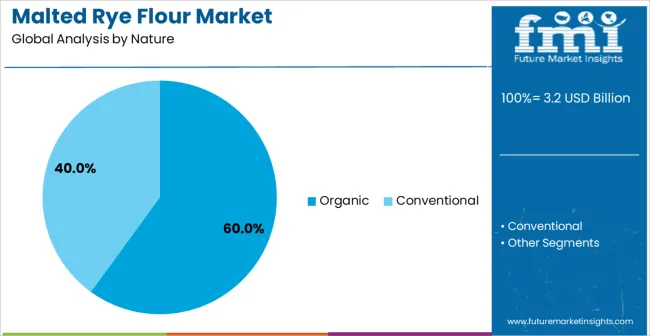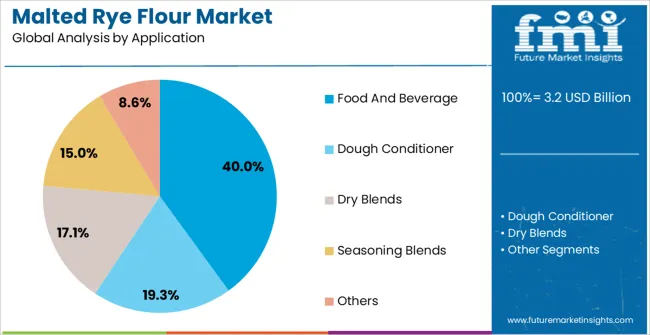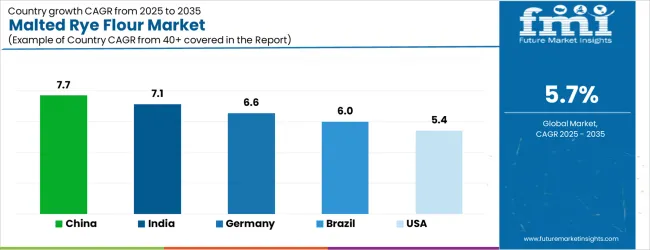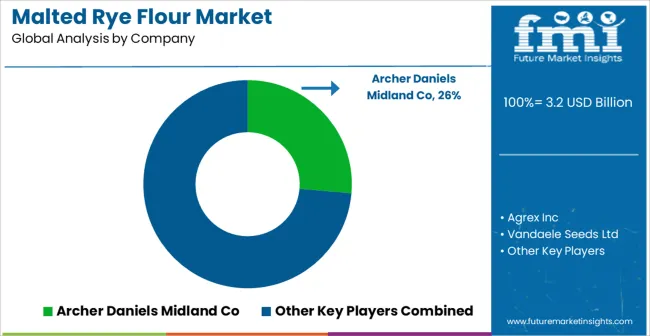The Malted Rye Flour Market is estimated to be valued at USD 3.2 billion in 2025 and is projected to reach USD 5.6 billion by 2035, registering a compound annual growth rate (CAGR) of 5.7% over the forecast period.
The Malted Rye Flour market is experiencing steady growth driven by the rising preference for healthier and functional food ingredients across both developed and emerging regions. The future outlook for this market is shaped by increasing consumer awareness about nutritional benefits, digestive health, and the use of whole grain products in daily diets. Growing demand from the food and beverage industry, particularly in bakery, confectionery, and specialty product applications, has strengthened market expansion.
Investments in sustainable agriculture and organic farming practices have further supported the adoption of organic malted rye flour, catering to the shift toward natural and additive-free ingredients. Additionally, the market benefits from innovations in milling and processing techniques, which enhance product quality, flavor, and shelf life.
The growing popularity of clean-label products and functional foods, coupled with the rising inclination toward plant-based diets, is expected to provide continued growth opportunities As health-conscious consumption rises globally, malted rye flour is anticipated to play an increasing role in both traditional and modern food formulations, sustaining long-term market growth

| Metric | Value |
|---|---|
| Malted Rye Flour Market Estimated Value in (2025 E) | USD 3.2 billion |
| Malted Rye Flour Market Forecast Value in (2035 F) | USD 5.6 billion |
| Forecast CAGR (2025 to 2035) | 5.7% |
The malted rye flour market is segmented by nature, application, and geographic regions. By nature, malted rye flour market is divided into Organic and Conventional. In terms of application, malted rye flour market is classified into Food And Beverage, Dough Conditioner, Dry Blends, Seasoning Blends, and Others. Regionally, the malted rye flour industry is classified into North America, Latin America, Western Europe, Eastern Europe, Balkan & Baltic Countries, Russia & Belarus, Central Asia, East Asia, South Asia & Pacific, and the Middle East & Africa.

The organic nature segment is projected to hold 60.0% of the Malted Rye Flour market revenue share in 2025, making it the leading nature category. This dominance is primarily driven by the growing consumer preference for naturally sourced, chemical-free, and sustainably produced food ingredients. Organic malted rye flour has gained popularity due to its perceived health benefits, cleaner nutrient profile, and alignment with eco-conscious lifestyles.
The segment’s growth is further reinforced by expanding availability through retail and specialty food channels, which increases accessibility for a broad range of consumers. Additionally, the rising trend of home baking and artisanal food preparation has contributed to higher demand for organic variants.
Enhanced processing technologies have also ensured consistent quality and flavor, making organic malted rye flour an attractive choice for both industrial and household applications As consumers increasingly seek healthier alternatives and sustainable products, the organic nature segment is expected to maintain its leadership position in the market.

The food and beverage application segment is expected to account for 40.0% of the Malted Rye Flour market revenue share in 2025, establishing it as a key application area. The growth of this segment is driven by the increasing incorporation of malted rye flour in bakery products, beverages, and functional foods, owing to its flavor-enhancing and nutritional properties.
The segment has benefited from the rising demand for whole grain and fiber-rich products, which support digestive health and overall wellness. Additionally, food and beverage manufacturers are leveraging malted rye flour to create specialty products that cater to evolving consumer preferences for healthier and natural ingredients.
The segment’s expansion is further facilitated by innovations in product formulations and processing techniques, which enhance texture, taste, and stability in finished goods As consumers continue to seek nutritious, clean-label, and functional food options, the food and beverage application segment is expected to remain a major driver of market growth.
Malted rye flour is the flour produced from rye grain which has undergone processing of milling from the whole rye kernel, followed by malting. Malting is a process that converts raw grain into malt, which can be further used for brewing or whiskey making. The processing of malted grain into flour offers it a completely new set of applications. Malted rye flour finds application as a natural dough conditioner in baking applications, such as dry blends for baked goods, bagels, crackers, pizza crusts and pretzels and seasoning blends.
Rye flour that has been malted provides excellent dough conditioning with enhanced qualities like extensibility and machinability. Malted rye flour also increases the shelf life of baked goods and gives them a sweet, aromatic flavor when it is added to dough for baking. Therefore, the majority of malted rye flour users are bakers who use it for its distinctiveness and to experiment with new and creative baking ingredients in order to change up the ingredients listed on their products.
In our new study, ESOMAR-certified market research and consulting firm Future Market Insights (FMI) offers insights into key factors driving demand for Malted Rye Flour.

| Country | CAGR |
|---|---|
| China | 7.7% |
| India | 7.1% |
| Germany | 6.6% |
| Brazil | 6.0% |
| USA | 5.4% |
| UK | 4.8% |
| Japan | 4.3% |
The Malted Rye Flour Market is expected to register a CAGR of 5.7% during the forecast period, exhibiting varied country level momentum. China leads with the highest CAGR of 7.7%, followed by India at 7.1%. Developed markets such as Germany, France, and the UK continue to expand steadily, while the USA is likely to grow at consistent rates. Japan posts the lowest CAGR at 4.3%, yet still underscores a broadly positive trajectory for the global Malted Rye Flour Market. In 2024, Germany held a dominant revenue in the Western Europe market and is expected to grow with a CAGR of 6.6%. The USA Malted Rye Flour Market is estimated to be valued at USD 1.1 billion in 2025 and is anticipated to reach a valuation of USD 1.1 billion by 2035. Sales are projected to rise at a CAGR of 0.0% over the forecast period between 2025 and 2035. While Japan and South Korea markets are estimated to be valued at USD 169.0 million and USD 87.7 million respectively in 2025.

| Item | Value |
|---|---|
| Quantitative Units | USD 3.2 Billion |
| Nature | Organic and Conventional |
| Application | Food And Beverage, Dough Conditioner, Dry Blends, Seasoning Blends, and Others |
| Regions Covered | North America, Europe, Asia-Pacific, Latin America, Middle East & Africa |
| Country Covered | United States, Canada, Germany, France, United Kingdom, China, Japan, India, Brazil, South Africa |
| Key Companies Profiled | Archer Daniels Midland Co, Agrex Inc, Vandaele Seeds Ltd, The Soufflet Group, Olam International Ltd, Louis Dreyfus Co. BV, and Agrozan Commodities DMCC |
The global malted rye flour market is estimated to be valued at USD 3.2 billion in 2025.
The market size for the malted rye flour market is projected to reach USD 5.6 billion by 2035.
The malted rye flour market is expected to grow at a 5.7% CAGR between 2025 and 2035.
The key product types in malted rye flour market are organic and conventional.
In terms of application, food and beverage segment to command 40.0% share in the malted rye flour market in 2025.






Our Research Products

The "Full Research Suite" delivers actionable market intel, deep dives on markets or technologies, so clients act faster, cut risk, and unlock growth.

The Leaderboard benchmarks and ranks top vendors, classifying them as Established Leaders, Leading Challengers, or Disruptors & Challengers.

Locates where complements amplify value and substitutes erode it, forecasting net impact by horizon

We deliver granular, decision-grade intel: market sizing, 5-year forecasts, pricing, adoption, usage, revenue, and operational KPIs—plus competitor tracking, regulation, and value chains—across 60 countries broadly.

Spot the shifts before they hit your P&L. We track inflection points, adoption curves, pricing moves, and ecosystem plays to show where demand is heading, why it is changing, and what to do next across high-growth markets and disruptive tech

Real-time reads of user behavior. We track shifting priorities, perceptions of today’s and next-gen services, and provider experience, then pace how fast tech moves from trial to adoption, blending buyer, consumer, and channel inputs with social signals (#WhySwitch, #UX).

Partner with our analyst team to build a custom report designed around your business priorities. From analysing market trends to assessing competitors or crafting bespoke datasets, we tailor insights to your needs.
Supplier Intelligence
Discovery & Profiling
Capacity & Footprint
Performance & Risk
Compliance & Governance
Commercial Readiness
Who Supplies Whom
Scorecards & Shortlists
Playbooks & Docs
Category Intelligence
Definition & Scope
Demand & Use Cases
Cost Drivers
Market Structure
Supply Chain Map
Trade & Policy
Operating Norms
Deliverables
Buyer Intelligence
Account Basics
Spend & Scope
Procurement Model
Vendor Requirements
Terms & Policies
Entry Strategy
Pain Points & Triggers
Outputs
Pricing Analysis
Benchmarks
Trends
Should-Cost
Indexation
Landed Cost
Commercial Terms
Deliverables
Brand Analysis
Positioning & Value Prop
Share & Presence
Customer Evidence
Go-to-Market
Digital & Reputation
Compliance & Trust
KPIs & Gaps
Outputs
Full Research Suite comprises of:
Market outlook & trends analysis
Interviews & case studies
Strategic recommendations
Vendor profiles & capabilities analysis
5-year forecasts
8 regions and 60+ country-level data splits
Market segment data splits
12 months of continuous data updates
DELIVERED AS:
PDF EXCEL ONLINE
Malted Wheat Flour Market
Malted barley flour Market Size and Share Forecast Outlook 2025 to 2035
Malted Milk Market Size and Share Forecast Outlook 2025 to 2035
Flour Mixes Market Growth – Specialty Baking & Industry Trends 2025 to 2035
Flour Substitutes Market Analysis by Baked Goods, Noodles, Pastry, Fried Food, Pasta, Bread, Crackers Applications Through 2035
Malted Milk Powder Market Trends - Growth & Industry Forecast 2025 to 2035
Flour Conditioner Market
Flour Improvers Market
Dryer Sheets Market Size and Share Forecast Outlook 2025 to 2035
Air Fryer Paper Liners Market Size and Share Forecast Outlook 2025 to 2035
Corn Flour Market Size and Share Forecast Outlook 2025 to 2035
Gel Dryer Market Size and Share Forecast Outlook 2025 to 2035
Bean Flour Market Size and Share Forecast Outlook 2025 to 2035
Air Fryer Accessories Market Size and Share Forecast Outlook 2025 to 2035
Air Fryer Market Analysis - Size, Share, and Forecast Outlook 2025 to 2035
Air Dryer Cartridge Market Analysis - Size, Share, and Forecast Outlook 2025 to 2035
Market Share Breakdown of Bean Flour Manufacturers
Gas Fryers Market
Deep Fryer Machine Market Size and Share Forecast Outlook 2025 to 2035
Pulse Flours Market Size and Share Forecast Outlook 2025 to 2035

Thank you!
You will receive an email from our Business Development Manager. Please be sure to check your SPAM/JUNK folder too.
Chat With
MaRIA